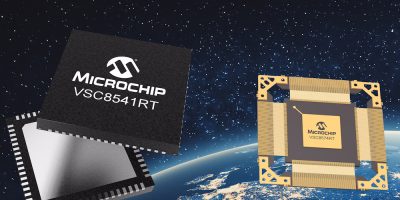Space computing reference design provides high speed data connectivity
Based on Microchip Technology’s radiation-tolerant GbE PHYs, the QLS1046-Space reference design has been developed by Teledyne e2v to provide high speed data connectivity in space applications.
The space computing reference design was presented at EDHPC 2023 (European Data Handling & Data Processing Conference, October 2-6, 2023 in Juan-Les-Pins, France) and enables high speed data routing in space applications.
It features Teledyne e2v’s radiation tolerant Qormino QLS1046-Space processing platform and data communication technology from Microchip. The radiation-tolerant design delivers robust, high performance processing, with enhanced sub-system connectivity capabilities. The QLS1046-Space has 30,000 DMIPS computing capability via the quad Arm Cortex-A72 cores and four to 8Gbyte of high speed DDR4 and multiple high speed interfaces. The architecture can process and route large incoming data rates from various sources, including telecommunication RF front ends, high resolution image sensors, radars, and other processing devices in the spacecraft.
The GbE interfaces ensure high-speed connectivity, supported by Microchip’s radiation tolerant Ethernet PHYs, claimed Teledyne e2v. The space computing reference design uses the VSC8541RT PHY to offer two RGMII links, and the VSC8574RT to offer two SGMII interfaces. The four Gigabit Ethernet connections could be ported up to seven Ethernet interfaces by exploiting all high speed interfaces available for high speed transfers between the QSL1046-Space and the other devices placed on different accompanying boards within the satellite or spacecraft. Target use cases include Earth observation, satcom applications, defence in space and space debris monitoring.
“In the vast majority of cases, modern space hardware will have a decentralised architecture. Normally communication between the constituent subsystems relies on 10 to100Mbit data transfer rates, explained Thomas Porches, application engineer at Teledyne e2v. “Greater levels of functional sophistication are now being incorporated for purposes like advanced telecommunication schemes, real time image processing, AI-driven analysis, and navigation.
“By working with Microchip, we’ve been able to significantly boost the interfacing capabilities for designs using the QLS1046-Space, leading to accelerated speeds plus extended propagation range. Consequently, they are completely aligned with what space customers are now demanding for edge computing applications.”
Staff from both Teledyne e2v and Microchip will present papers relating to their involvement in edge-located processing and inter-board communication for space deployments at the conference.




